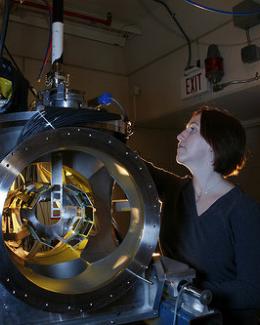Abstract
The 30P(p,γ)31S reaction plays an important role in understanding the nucleosynthesis of A≥30 nuclides in oxygen-neon novae. The Gaseous Detector with Germanium Tagging was used to measure 31Cl β-delayed proton decay through the key Jπ=3/2+, 260-keV resonance. The intensity I260βp=8.3+1.2−0.9×10−6 represents the weakest β-delayed, charged-particle emission ever measured below 400 keV, resulting in a proton branching ratio of Γp/Γ=2.5+0.4−0.3×10−4. By combining this measurement with shell-model calculations for Γγ and past work on other resonances, the total 30P(p,γ)31S rate has been determined with reduced uncertainty. The new rate has been used in hydrodynamic simulations to model the composition of nova ejecta, leading to a concrete prediction of 30Si:28Si excesses in presolar nova grains and the calibration of nuclear thermometers.


